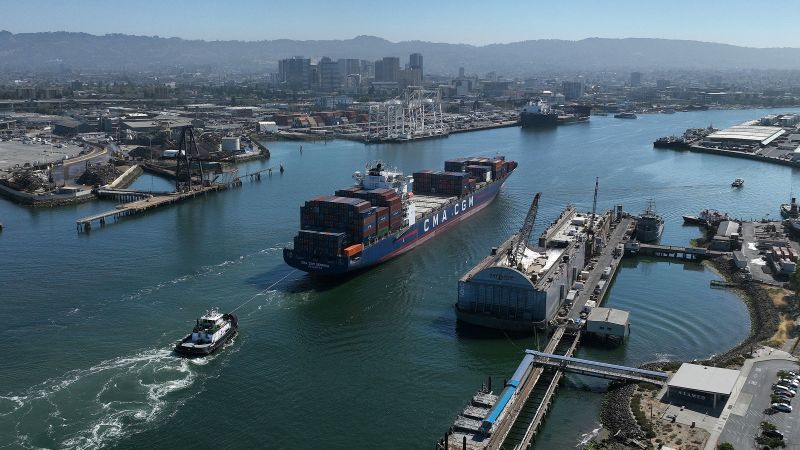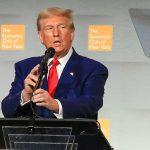Former President Donald Trump wants to spend trillions of dollars on tax cuts. His plan to pay for that is alarming some mainstream economists.
Trump proposed sweeping tariffs on all $3 trillion worth of imports into the United States, including a 60% tariff on imports from China and a 10% across-the-board tariff on imports from other nations.
Recently, Trump doubled down on the threat, saying he is considering tariffs of up to 20% on most imports in a bid to protect working-class jobs and punish what he labels unfair trading practices.
In theory, the unprecedented tariff hikes could raise trillions of dollars, funds that would help cover the cost of the tax cuts. However, many economists warn that those tariffs could backfire – badly – by raising prices on American families, killing jobs and setting off a global trade war.
It’s part of the reason Goldman Sachs in an analyst note this week said Trump’s economic policies – particularly on trade – would cause America’s economy to shrink. By contrast, Vice President Kamala Harris’ economic policy proposals would grow the economy, Goldman Sachs predicted.
Goldman and other experts fear Trump’s tough proposed trade tactics could worsen the affordability crisis in America.
“It’s one of those magical economic proposals that can actually cause inflation and put you into a recession – at the same time,” David Kelly, chief global strategist at JPMorgan Asset Management, told CNN in a phone interview.
Kelly warned that tariffs are a “perfect stagflation machine,” threaten to scramble supply chains and invite a punishing response from trading partners.
“It’s a two-year-old’s mentality: You punch someone in the nose and expect them not to punch you back,” he said.
Trump plans to detail his economic vision for America during a major address on Thursday at the New York Economic Club.
The speech comes as a new CNN poll finds that economic issues remain the biggest concern for voters, with an average of 39% of likely voters across six battleground states choosing it as their top issue.
Trump’s trade proposals could be equivalent to a $3 trillion tax hike, warned Douglas Holtz-Eakin, president of the center-right think tank the American Action Forum.
“It’s enormously protectionist and terrible economic policy,” said Holtz-Eakin, who served as an economic adviser to former President George H.W. Bush and an adviser to the 2008 presidential campaign of GOP Sen. John McCain.
It’s hard to know how much of Trump’s tariff talk is a negotiating tactic and how much he intends to enact if he were reelected, noted Mark Zandi, chief economist at Moody’s Analytics.
“But even just a step in that direction is problematic. It’s a very bad idea. If there is anything that most economists can agree on, it’s that tariffs are bad,” Zandi said.
Trump campaign national press secretary Karoline Leavitt disputed the economists’ assessments in a statement to CNN.
“So-called economists and experts doubted President Trump’s economic plans in his first term. They were proven wrong then and they’ll be proven wrong again… President Trump successfully imposed tariffs on China in his first term AND cut taxes for hardworking Americans here at home – and he will do it again in his second term,” Leavitt said in the statement. “President Trump’s plan will result in millions of jobs and hundreds of billions of dollars returning home from China to America.”
Harris’ campaign accused Trump of lying to Americans about his policies.
“Donald Trump is denying this broad, bipartisan consensus, ‘hoping that most economic analyses of his ideas are dead wrong’ and blatantly lying to the American people about the severe costs and consequences of his economic plans,” Brian Nelson, a top economic adviser to Harris, wrote in a memo obtained by CNN.
Trump has championed tariffs as a way to help working-class Americans by protecting workers from unfair trade practices and as a negotiating tactic to reach more favorable trade agreements. However, some experts fear they will do the opposite.
Trump’s call for a 20% across-the-board tariff combined with a 60% tariff on China would cost the typical middle-income household more than $2,600 a year, according to updated estimates published last month by the Peterson Institute for International Economics.
That’s up from the researchers’ previous estimate of $1,700, which was based on a 10% tariff.
Importantly, these estimates do not factor in the impact from potential foreign retaliation, slower economic growth or lost competitiveness that a global trade war could cause. The actual impact could be far higher.
And the pain would not be evenly divided among families, the Peterson Institute found: Although households in all five income quintiles would lose money from the Trump tariffs and tax cuts, the lowest earners would be hurt the most.
“The losses are greatest for those at the bottom of the income distribution,” researchers Kimberly Clausing and Mary Lovely wrote in an August update. “The top 1 percent would experience net gains in income because losses from tariffs are more than offset by Trump’s proposed tax cuts.”
Trump-imposed tariffs on imported solar panels, steel and aluminum and Chinese-made goods have cost Americans more than $230 billion, according to US Customs and Border Protection.
And US states more exposed to US tariffs on imports from China experienced “lower increases or even decreases” in employment and output between 2018 and 2019, according to a study from St. Louis Federal Reserve economists.
But tariffs on Chinese goods have become popular on both sides of the aisle. Notably, the Biden-Harris administration has kept in place most of the Trump-era tariffs. In May, President Joe Biden announced increased tariffs on $18 billion worth of Chinese goods, including electric vehicles, solar cells and computer chips.
Harris has not detailed specific plans for ramping up or dialing back tariffs.
Trump has called for extending his signature 2017 tax cuts, which expire next year if no action is taken by Congress.
Trump has argued that extending the tax cuts will boost the economy, create jobs and help families. However, researchers from Princeton University, the University of Chicago, Harvard University and the US Treasury Department earlier this year found that while the 2017 tax law boosted investment in the American economy and helped to modestly increase wages, the tax cuts did not pay for themselves.
In any case, extending the tax cuts would be an expensive proposal.
Extending the individual income tax provisions from the 2017 tax law alone would cost $3.4 trillion over a decade, according to estimates from the nonpartisan Penn Wharton Model. By contrast, Harris’ economic plans would cost between $1.2 trillion and $1.4 trillion over a decade, as of Penn Wharton’s latest model, which did not account for policy proposals Harris made this week.
Trump has suggested cutting the corporate tax rate again, dropping it from 21% to 20% or even 15%. The Penn Wharton model estimates a cut to 15% and extending the business tax provisions of the 2017 law would pile on another $1.2 trillion in costs.
Beyond the tax cut extension, Trump has also proposed eliminating taxes on Social Security benefits. That would cost $1.2 trillion over a decade, according to Penn Wharton.
The Trump campaign has not detailed significant spending cuts or tax hikes to offset these tax cuts.
The Penn Wharton model does not incorporate the revenue benefits from the potential tariff hikes, noting that key implementation details are “missing” and cautioning that the consequences of a new trade war could be costly.
“While new import taxes on tariffs could raise several trillion dollars in new revenue over the next decade, they could also lead to revenue losses due to potential retaliatory actions from other governments and other economic dynamics,” the report said.
CNN’s Katie Lobosco contributed reporting.
Read the full article here




